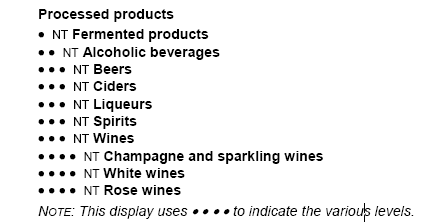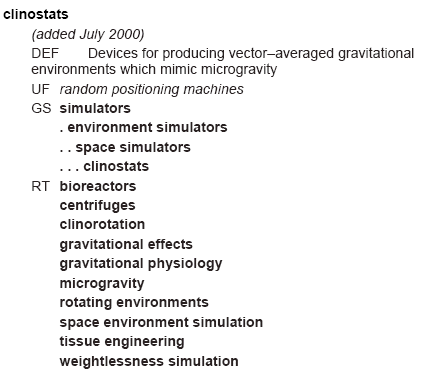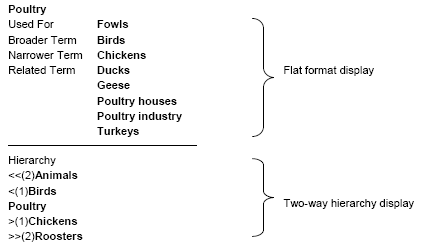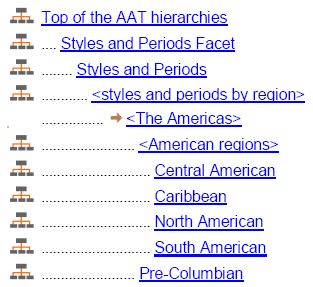5.3 Types of Displays
5.3.4 Hierarchical Displays (9.3.4)
Taxonomies, thesauri, and any vocabularies with established relationships between terms should
include a hierarchical display that illustrates the relationships. There are a number of variations in
how hierarchical displays can be structured.
a) Multilevel hierarchies
b) Tree Structure
c) Top Term Structure
d) Two-Way Hierarchical Structure
e) Broad categories
f) Faceted
The following sections (Sections 5.3.4.1 through 5.3.4.6) describe the most commonly used forms for displaying hierarchical
relationships among terms. See also section 5.3.1.2 on Flat Format Displays.
5.3.4.1 Multilevel Hierarchical Displays (9.3.4.1)
A multilevel hierarchical display format saves time for the controlled vocabulary user because all
levels of the broader and narrower terms related to a given term are immediately visible. This is in
contrast with the flat format described above, in which only one level of broader or narrower terms is
displayed and the user is required to navigate from term to term one level at a time to discover the full hierarchy.
In both multilevel formats described in the following sections, the sibling terms (the related terms at
the same level) of the given term are only displayed by viewing the broader term.
Because the entire hierarchy is repeated over and over again, these display formats are far more
space-consuming than the flat format and hence less desirable for a printed controlled vocabulary.
However, if the hierarchies are not very deep, e.g., only three or four levels, the extra space required
could be justifiable.
5.3.4.1.1 Multilevel Broader and Narrower Terms Hierarchical Displays
This type of multilevel display employs special notation, such as BT1, BT2 (one level broader, two
levels broader) and NT1, NT2 (one level narrower, two levels narrower), to show the full hierarchy for
each term.
Example 152: Multilevel hierarchy display using numerical level notation

Source: Thomson Gale Master Thesaurus, Synaptica® software by Synapse Corporation
Example 153: Multilevel hierarchy using symbol level notation

Source: AGROVOC
5.3.4.1.2 Generic Structure Hierarchical Displays
Multiple levels of hierarchy may be indicated without broader term / narrower term (BT/NT) notation
by using the abbreviation GS (generic structure) with indentation and punctuation marks, such as
periods as cues to the levels of hierarchy.
Example 154: Multilevel hierarchy with generic structure notation

Source: NASA Thesaurus
5.3.4.2 Tree Structure (9.3.4.2)
In a tree structure, each term is assigned a classification notation or line number. This leads the user
from the alphabetic display to the full hierarchical display (sometimes called systematic display or
classified display), which is placed in a separate sequence. In the flat format or multilevel structure,
hierarchical relationships may be built from the bottom up; in a tree structure, they are often built from
the top down. The power of a tree structure can be exploited more fully using electronic display
technology. (See Z39.19 section 9.4.2 and 9.4.3).
Example 155: Tree structure using classification notation

Source: Medical Subject Headings
If a hierarchical classification scheme is applied to a tree structure, its notation must be carefully
developed so that it will be hospitable to interpolation at any level. Computer-generated or humanly assigned
line numbers can be revised when terms are added, but the notation is not expressive, i.e.,
it does not reflect the levels of hierarchy.
Pure notation, consisting of either letters or numbers, has a smaller base than mixed or alphanumeric
notation and is therefore less hospitable to new terms. Mixed notation can, however, create problems
for novice users, who can have difficulty locating and understanding the codes.
5.3.4.3 Top Term Structure Displays (9.3.4.3)
In a top term structure, the alphabetic display includes all the relationships found in the flat format,
with the addition of a relationship indicator for the top term (TT) of the hierarchy. The latter is
equivalent to the broadest term in a generic structure.
The top term leads the user to a separate sequence of the controlled vocabulary in which top terms
are arranged alphabetically, with each top term followed by all its narrower terms, arranged
hierarchically on various levels.
Example 156: Top Term Structure

Source: Legislative Indexing Vocabulary Thesaurus
5.3.4.4 Two-Way Hierarchical Structure Displays (9.3.4.4)
A two-way hierarchical display option is generally appended to a flat format controlled vocabulary.
Each term is an access point, and all levels of broader and narrower terms are displayed, generally
without notation and with indentation as a cue to hierarchy. This format is logically equivalent to the
generic structure, i.e., one can view all of the broader and narrower terms of a term in a single
display.
Example 157: Two way hierarchical structure

Source: Thesaurus for Graphic Materials
5.3.4.5 Broad Categories Displays (9.3.4.5)
The alphabetic arrays of some controlled vocabularies include numbers that identify the broad
category to which each term belongs. The notation for the category may be searchable online or
used for purposes of selective dissemination of information. Such controlled vocabularies generally
feature a separate section that displays the terms for each numbered category or subcategory in an
alphabetic sequence, undifferentiated in terms of hierarchical levels.
Example 158: Broad categories (numbered / classified):

Source: DTIC Thesaurus
5.3.4.6 Faceted Display (9.3.4.6 )
Some controlled vocabularies provide a display of the terms organized according to the broad
categories or facets to which the term belongs. Facets may have a hierarchical arrangement as well
so that narrower facets are arranged within broader categories.
Example 159: Faceted Display

Source: Art and Architecture Thesaurus
| Table of Contents |
| 1. Why Vocabulary Control | 2. Principles | 3. Structures | 4. Semantic Relationships |
| 5. Displays | 6. When to use | 7. Examples of use | 8. About Z39.19 |
©NISO, 2005 http://www.niso.org/
Source: Based on ANSI/NISO Z39.19-2005 ISBN: 1-880124-65-3
Guidelines for the Construction, Format, and Management of Monolingual Controlled Vocabularies







